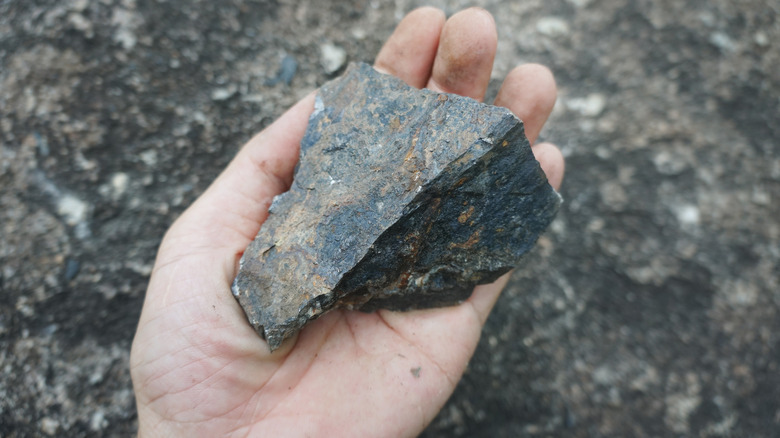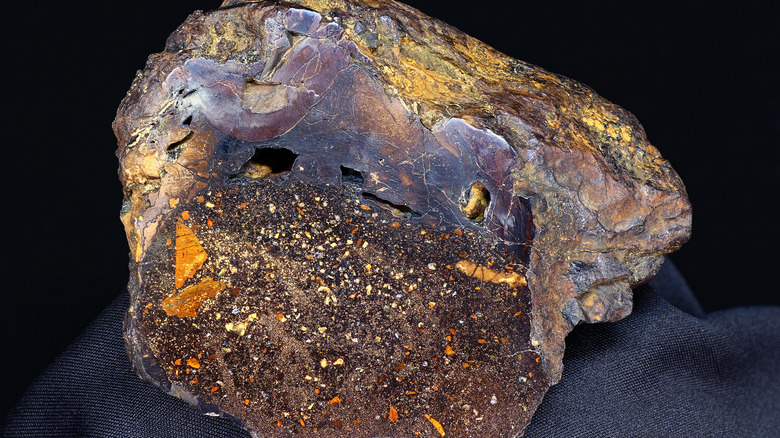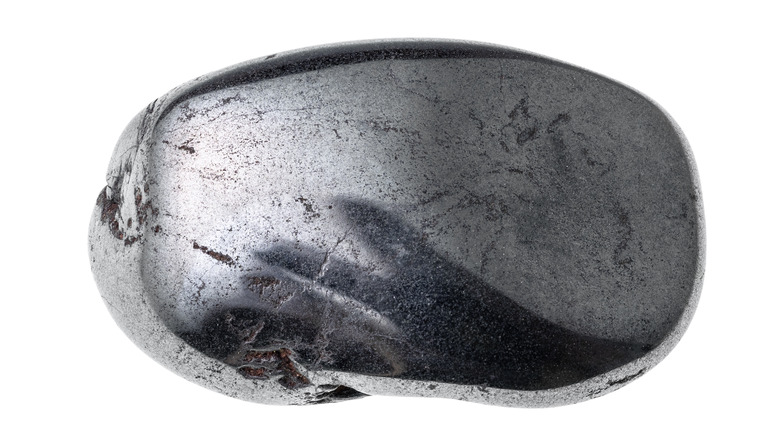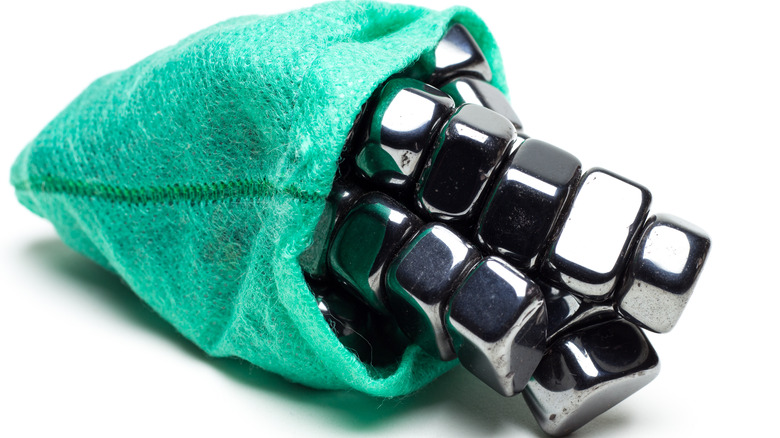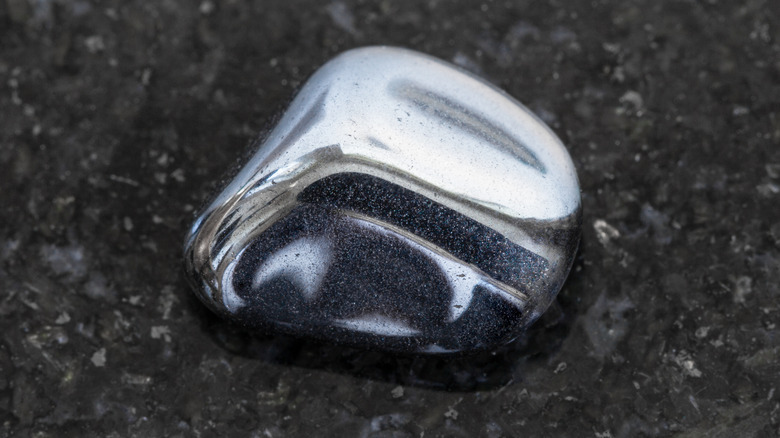What Is A Hematite Stone And How Is Used?
Home decorating goes beyond mere aesthetics — you also want to create a warm, safe, and happy vibe. That's where hematite can help. This grounding stone often found in jewelry also works to bring some balance and protection to your residence. Known also as the bloodstone — the word's origins are Greek and "hematite" translates to blood — it consists of iron oxide crystals and can have a metallic, gray, black, or reddish cast (from My Crystals). Back in the days of Ancient Rome, the popular stone was found on all sorts of items, from weapons to jewelry to armor because its inky color inspired intimidation and protection, said Crystals and Jewelry.
Hematite is perfect for those who feng shui their space since it protects and stabilizes any negativity in your home, according to The Spruce. Because the stone is associated with the root chakra, it also offers grounding capabilities. It is said to stop anxiety, offer balance, and to create a calm atmosphere, per The Bead Traders. Hematite also improves focus, concentration, and mental acuity. Why wouldn't you want this force of nature in your home?
What is hematite?
Hematite is a readily available as iron oxide, with a composition of 70% iron and 30% oxygen. Once mined extensively throughout the globe, now the big producers of the mineral are Australia, Brazil, Canada, China, India, Russia, South Africa, Ukraine, United States, and Venezuela. The natural stone is used for all sorts of things, from creating pigments to radiation shielding to home décor products (via Geology.com).
Gemstones come in a range of colors, from silver to gray to black. Some have an iridescence or reddish tint, said Gem Select. When polished and cut, hematite becomes more metallic-looking, featuring a silver or gray hue. You can tell the stone is hematite because it leaves a red streak if you rub it against paper, which is from the iron oxide the mineral contains.
For more than 3000 years, humans have celebrated hematite's intrinsic abilities, according to Jewels for Me. Ancient Babylonians believed it offered warriors strength, and their soldiers carried it into battle. Farmers used it as a talisman during the Middle Ages to produce better crops. For home feng shui, hematite can create more balance in your life and help absorb negativity, said The Spruce. It can also aid mental activities, including studying, meditation and finding clarity.
How to use hematite
Hematite helps your home's feng shui — the Chinese art of creating harmony by optimizing energy forces in your interior space, according to My Domaine. Laura Benko, author of "The Holistic Home," told the publication that even small adjustments can offer a "profound impact on your daily life." You want to keep the energy flowing through your home in a way that meets your daily needs.
Hematite, said Know Feng Shui, creates a positive atmosphere in your house, infusing it with a degree of protection, centering, and calming properties. You can purchase stone statues, like a Laughing Buddha to all sorts of animals figurines. Hematite is also available in loose stones. You can carry these with you, or place them in your home in specific spots. For instance, the north section favors careers and placing hematite there can enhance your advancement at work.
You can also rev up your workout by placing a piece of it in your gym area or yoga mat, said Love to Know. Because the stone can energize you, it's probably best to remove it from your bedroom in the evenings. Putting either polished black or gray hematite in the west/northwest areas in your home can upgrade energy levels for children, travel, and mentorships. Wanna bring more calm to your relationships? Put hematite in the southwest and northeast spaces to balance your marriage or partnership, and enhance your wisdom. All this is as easy as buying a few stones and a compass.
The meaning of hematite
When the world feels chaotic and leeches your energy, hematite can offer grounding and balance, said Energy Muse. For centuries, people have believed that it offers calming and centering properties — and that it helps optimize the root chakra, an energy point that anchors humans to the earth. The word itself comes from Greek's "haima," which translates to blood. The ancients also linked hematite to the god of war, Mars. Greeks, Romans, and Native Americans going into battle pulverized the stone and made a red paint that they decorated their bodies with; they believed the hematite could provide safety.
Many civilizations used the stone as well. The red in cave paintings from the Paleolithic period came from the mineral. Mesopotamians put it in their medicines, crediting it with cooling their blood, as did the Egyptians who thought the iron oxide reduced inflammation.
Jean Baptiste Romé de I'Isle is credited with discovering the mineral in 1773, first dubbed haematite, and removing the first "a," reported The Crystal Council. Besides residing on earth, the stone was seen on Mars by NASA's Mars Global Surveyor and the 2001 Mars Odyssey spacecraft. Hematite often needs water to form, and scientists are hoping to prove whether flowing water ever appeared on the planet, according to NASA.
Types of hematite
Hematite is an oxide mineral, which comes in several different hues from red to orange to brown.The gemstone has a few varieties, including:
- Rainbow Hematite: This type is a multi-colored version that features iridescence from a slight coating of an aluminum phosphate. It is rare in nature, but human-made versions fill the stores.
- Specularite: This hematite contains a reflective flaky, layered surface in an aggregate form.
- Kidney Ore: This variation earns its name because it really looks like the human organ. It can also appear in botryoidal form where the mineral looks almost like grapes due to all of its lumpy pieces.
- Iron Rose: These hematite flakes puts clusters together so the stone mimics a rose and all its lovely petals.
You might have heard about magnetic hematite, a slick and shiny black-stoned variety, that sticks together with other pieces of the substance. Despite the name, this is not considered a hematite gemstone, according to Gem Select.
Why you should use hematite
Who doesn't want more balance and grounding in their life? Hematite can heal your body and home, according to The Spruce. The mineral is associated with the root chakra and that makes it stabilizing. Keeping one — or a few — around supports better self-care and ensures that you get enough food, water, and sleep. Hematite also deters negative thoughts; the stone's dark colors help reduce negative energy, allowing you to see the more positive parts of life.
If you worry that you will place hematite in the wrong spaces, don't fret. According to Hunker, while some places are better than others, you won't bring hardship to your life with imprecise placement. You are setting hematite on a dresser or table — not spackling it to a wall. If the energy feels off, just move the rock. That said, some areas can really benefit from hematite, like the front door entry way. The protective vibes from the stone will fill you with self-confidence as you leave, setting you up to meet the day's challenges in an upbeat and calm way. Hematite can also shield you from danger, according to Conscious Items. It also helps lead you safely back home.
How to care for hematite
Hematite is a medium hardy stone, with a Mohs scale hardness rating of 5 to 6 (out of 10), said the Jewelry Shopping Guide. This means it can become scratched when moving items like a knife or glass plate against the mineral. Some hematite can also be brittle so if you smash the stone, it can fracture.
If you want to clean hematite, a bit of liquid soap and warm water should do the trick. You can use a soft cloth or brush, but don't try anything abrasive, including chemical cleansers like bleach. An old toothbrush can remove any tough-to-eliminate marks. Allow the stone to air dry. You can also try making it shine with a polishing cloth (via Gem Coach).
You can store your hematite stones or items in cloth pouches or fabric-lined jewelry boxes, advised Gem Coach. Avoid having it touch other stones, crystals, or metals or your risk scratching the hematite. Be careful when handling the mineral because the hematite's surface shows scratches easily.
